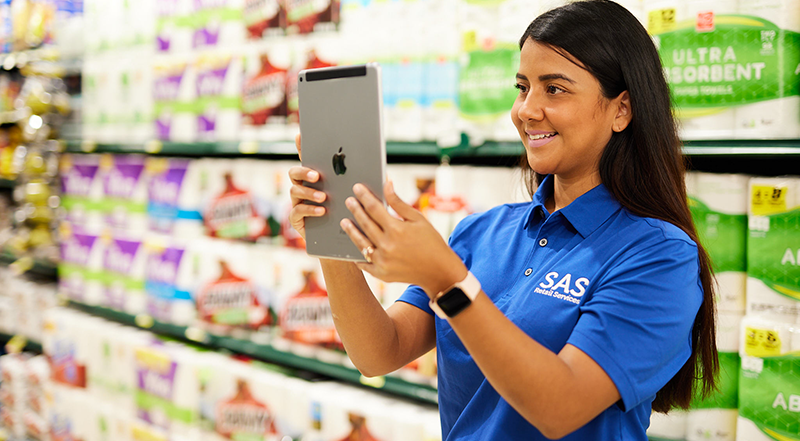In the ever-evolving landscape of the retail industry, innovative technologies are reshaping the way businesses operate, enhancing customer experiences, optimizing processes, and have the potential to tackle the ubiquitous out-of-stock issues at that shelf. This article in Progressive Grocery comments on how AI is innovating Category Management.
Georges Mirza comments: “Computer vision is the critical technology that enables retailers to innovate and enhance their operations. Improving scalability, speed, and accuracy can boost customer satisfaction both in-store and online. Furthermore, it has the potential to streamline processes, reduce labor costs, and enhance the overall shopping experience by facilitating product identification and understanding shopper behavior.” 1.
It’s our view that computer vision, coupled with artificial intelligence (AI) however, is not enough to create utopia at retail. Here’s why.
It’s true that Artificial Intelligence (AI) is transforming the grocery retail industry by offering innovative solutions to enhance various aspects of the shopping experience. With AI technology, retailers can also analyze vast amounts of data to gain valuable insights, make data-driven decisions, and optimize their operations.
IMPROVING CUSTOMER EXPERIENCE THROUGH PERSONALIZATION
AI enables grocery retailers to personalize the shopping experience for individual customers. By analyzing customer data, purchase history, and preferences, AI algorithms can offer personalized recommendations, customized promotions, and targeted marketing campaigns.
Personalization not only enhances customer satisfaction and loyalty but also drives sales and revenue growth. With AI-powered solutions, retailers can create tailored shopping experiences, personalized offers, and targeted advertisements, ensuring that customers find the products they need and enjoy a seamless shopping journey.
OPTIMIZING STORE LAYOUT AND SHELF MANAGEMENT
AI-powered computer vision technology is revolutionizing store layout optimization and shelf management in grocery retail. By analyzing video feeds, AI algorithms can identify and track product placements, monitor shelf conditions, and optimize product assortments.
With computer vision, retailers can gain insights into shopper behavior, understand customer traffic patterns, and optimize store layouts accordingly. This helps improve product visibility, reduce out-of-stock situations, and enhance the overall shopping experience for customers.
STREAMLINING CHECKOUT AND PAYMENT PROCESSES WITH AI
AI-powered solutions are streamlining checkout and payment processes in grocery retail, making them faster, more convenient, and frictionless. Automated checkout systems powered by AI can accurately identify and price products, enabling customers to skip long queues and check out with ease.
Furthermore, AI algorithms can detect fraudulent activities, enhance security measures, and facilitate seamless payment transactions. By leveraging AI technology, grocery retailers can reduce waiting times, improve operational efficiency, and provide a seamless checkout experience for customers.
ENHANCING INVENTORY MANAGEMENT WITH AI
One of the key challenges in grocery retail is managing inventory effectively to ensure products are always available on shelves while minimizing waste and overstocking. AI-powered solutions offer real-time inventory monitoring, demand forecasting, and automated replenishment systems.
By analyzing historical sales data, market trends, and external factors such as weather conditions, AI algorithms can accurately predict demand and optimize inventory levels. This not only reduces the risk of stockouts or overstocking but also helps retailers save costs and improve overall supply chain efficiency.
COMPUTER VISION IDENTIFIES ISSUES ON THE SHELF
AI-powered computer vision is also getting better and better in identifying issues such as an item being out of stock and whether that item is in its proper place on the shelf. In addition, POG compliance, a key to successful sales support at retail benefits from computer vision and AI. Herein lies the rub. While the technology drives data collection and potential for better decision making, at the store level, at that moment of truth for the shopper, knowledge does not translate into a fix for that out-of-stock, hidden, or languishing-in-the-back item the shopper is looking for.
Where we think the brilliance is, is in combining computer vision, AI and expert Associates at retail to close the loop on those issues at the shelf.
SAS-Associate-Taking-A-Picture-at-the-Shelf-Web
MERGING TECHNOLOGY AND HUMAN EXPERTISE FOR ULTIMATE SUCCESS
At its core, our solution, the SAS-Rebotics platform leverages the capabilities of artificial intelligence to empower Associates within stores. Using a mobile device similar to a smartphone, these Associates can capture digital images of store shelves, which are then transmitted to the platform’s servers for immediate processing. Within minutes, a real-time report of each section of the store is generated and shared with the merchandising associates. This report offers a prioritized work plan, pinpointing issues that require attention based on the data collected by the technology.
In the past, merchandising associates would spend valuable time identifying these issues manually. With SAS-Rebotics, they can now direct their efforts towards actually addressing the problems. The technology has demonstrated that it is three times more efficient at recognizing out-of-stocks compared to the human eye trying to locate gaps or misplaced items. Armed with the generated recap and issue list, the SAS Retail Services team can swiftly correct and increase on-shelf availability, directly impacting store sales for retailers. 2
Furthermore, the platform provides stakeholders with an ongoing, accurate assessment of on-shelf conditions. This data is invaluable for tackling short-term inventory and merchandising challenges while identifying opportunities for improvement. This innovative solution of technology powering people to efficiently fix issues holds the potential to drive sales and revolutionize the way retailers manage their inventory and merchandise. As technology continues to advance, the retail industry will continue to embrace these transformative tools to stay competitive and meet the ever-evolving demands of shoppers and consumers.
Curious about laser-focussing labor and improving shelf conditions? Learn more.
1. Progressive Grocer 10/03/2023 – Innovating Category Management: Disrupting Traditional Approaches. Differentiate solutions in grocery by using computer vision and AI – Georges Mirza
2. Case Study – November 2019 – Quantifying and Validating the Retail Value Delivered through the SAS-Rebotics Platform – Dr. Thomas W. Gruen Ph.D. and SAS Retail Services

